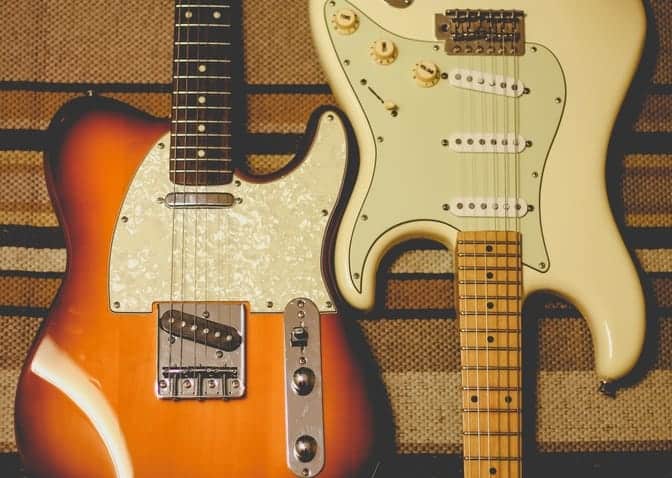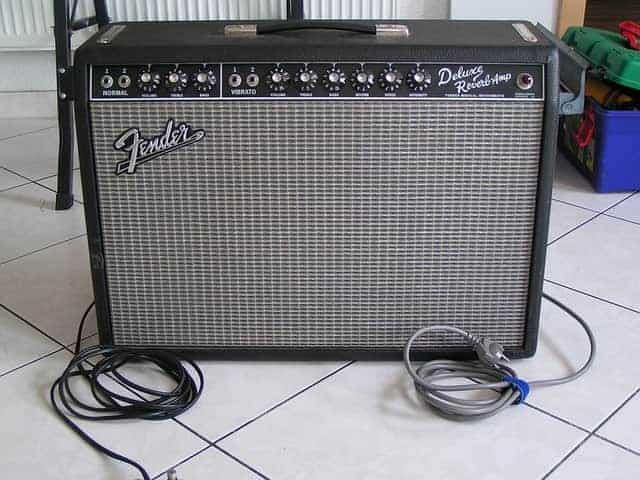
When it comes to playing funk, you as the guitarist are a cog in the funk machine! U
I am a keen rhythmic funk player influenced by legendary players: ‘Nile ‘Rodgers,’ ‘John Frushante,’ and ‘Prince’.
I decided to write this post for players getting started with the sound and the usual gear for funk guitar.
So how can you set yourself up for a funky guitar tone?
The sound of Funk guitar is renowned for being ‘clean’ ‘bright’ and ‘spanky’ which enhances the groove when combined with rhythmic playing.”Although considered a ‘playing style’ more than a specific tone. Certain guitars and effects can help optimize the core sound of funk guitar.
The Technique
As mentioned, funk guitar is noted for a ‘playing style’ more than a certain tone. For example, the listed techniques will need to be on point…
- Left hand muting (to deaden strings creating rhythm)
- Solid right hand strumming
- Locking in with the beat, groove and tempo
- Basic funk chords
- Good lead playing
When you have these techniques mentioned above down with ease, next is matching a ‘clean’ ‘bright’ and ‘spanky’ tone with some recommended optional effects for tonal variety. Let’s start with guitars…
Best Guitars for Playing Funk

Keep in mind, there is no ‘best electric guitar’ when it comes to the sound of funk.
Nearly every electric guitar can groove along to funk, however, some sound better for funk than others. With that said, it all comes to personal preference!
With that said, the perfect funk
Why? Because the general conventional sound is recognized for being: ‘clean’, ‘spanky’, and ‘rhythmic’.
Therefore guitars that can produce a clean and punchy sound are
There are many guitars that make the ideal ‘funk machine’ some traditional recommendations are…
- Stratocaster
- Telecaster
- Jazzmaster
- Any semi-hollow guitar with humbuckers or P90s
- Gibson or Epiphone SG
- Gibson or Epiphone Les Paul
- Most PRS models
- Ernie Ball Music Man
If I had to pick the best guitar for any aspiring funk player, it is undoubtedly is a toss-up between the legendary ‘Stratocaster’ and ‘Telecaster’.
Both guitars have been immortalized on a large percentage of famous funk records and are usually the main weapon of choice for players out there for good reason…
- Great tone
- Pickup selection
- Single coil pickups
- Thin and trebly sound
- Highly playable
- Lack of sustain
- Versatile
- Great for beginners
Want a list of the best guitars for clean tones? I have an awesome roundup post of the 9 best guitars for pristine clean tones. You can read his post here!
Essential Funk Gear Video (Watch Below)
Other Guitar Requirements
Guitars with a good selection of pickup options such as a ‘3-way’ or ‘5-way’ pickup selector are good choices.
The reason being these combinations offers a range or ‘blend’ of clean tones to choose from to sculpt a thin or more mid-focused clean sound.
A bridge pickup will offer the thinnest and
Comfortable Neck
Added requirements are guitars that are comfortable to play as in light with good high neck access and with a suitable action (string height) for optimal fretting and scratching.
A neck that feels smooth to play up and down the fretboard that doesn’t feel too chunky in the palm when fretting chords is another consideration.
All necks will feel different to all guitar players out which is a subjective selection, so it’s best to try a number of guitars out there and see what feels best for you.
Best Pickups for Funk
It has to be noted, there are no set pickups for the best tone for funk as it is all subjective for the player.
Your sound will depend on your unique tastes. However, when it comes to guitar and pickup combination, each type will affect tone, and which one you prefer comes to your personal preference.
Single-Coil Pickups – Overview
When it comes to the best pickups for playing funky grooves, single coils have been the most popular choice.
The reason is they offer the most ‘clarity,’ ‘bite,’ and ‘
Single coils go hand in hand when it comes to clean tones and is the staple pickup
Single coils also combined with a large scaler length (25.5”) are the perfect match for a thin and bright tone compared to humbuckers with a guitar with a shorter scale length,
A feature of single-coil pickups is that they lack sustain. Now usually this is hotly desired by guitarists in other forms of genres: rock, metal, blues, etc for sustaining notes for solos.
However, funk players prefer the short ‘snappy’ sound of the guitar which optimizes the rhythm and percussive sound of funk playing.
The only negative with single coils is that, unlike humbuckers, they cannot cancel their own hum when played at a high volume through a noisy tube amp.
This also comes apparent when slapped with a bit of distortion or gain. Luckily, funk is not associated with high gain sounds.
It would be advisable to use subtle overdrives to act as a ‘clean boost’ that can get a really twangy and spanky sound when combined with single coils.
What about P90 Pickups?
P90s are also a great alternative pickup for clean funk tones which are standard pickups on semi-hollow guitars more notably the Gibson 335, early Gibson Les Pauls, and the Fender Jazzmaster.
P90s are essentially brighter than humbuckers but beefier than single coils, essentially placing them right in the middle of the sound chart, almost a blend of both single coil and humbucker.
I have a post that dives deep into the tone and uses for P90 pickups. You can read this post here!
Humbucker Pickups for Funk?
Humbuckers although excel at heavier styles such as rock and metal. When it comes to funk,
Yet, they can still produce a good enough clean tone which offers a naturally compressed tone compared to single coils.
Their sound is beefier and more ‘in your face’ more designed for distortion tones as they can cancel the ‘60 second cycle hum’ that is generated by pickups.
Humbuckers combined with clean are rounder with a pronounced bottom-end compared to single-coils.
As a side note, there is a slight difference in tone between covered vs uncovered humbucker covers. Open coil vs covered humbuckers. You can learn the differences here!
Common Funk Guitar Pedals and Effects
When looking to assemble a guitar tone aimed at the funk! Some essential pedals and effects must be at the ready for the percussive sound of funk with some optional extras.
The Compressor Pedal
A compressor is essential for enhancing and stepping your clean tone up a level when your amp and guitar are paired together.
This pedal is of high value for funk players as they function to increase the lost frequencies of a signal to add ‘attack’ and ‘brighten’ a guitar tone for maximum punch. They add ‘snap’ and ‘pop’ to the clean tone giving it a new lease of life.
Essentially a compressor ‘compresses’ the high and low frequencies together creating a more balanced and even volume.
For dirty and distorted tones this is not required as this already creates natural compression. For clean tones, however, it will be essential!
Why is Compression So Important?
A compressor will be ideal for a number of reasons. The first is when playing palm mutes and rhythmic scratching, (very common for funk playing.)
These techniques produce slightly more volume than unmuted notes, meaning that the muted scratches get a slight volume boost.
A compressor will allow the volume to be compressed allowing for a more balanced sound and performance.
The second reason is that a compressor will ‘brighten’ the tone and give a boost in output giving the sound added crispiness and punch.
This is a must-have, especially for a single-coil guitar which will hugely benefit from a compressor.
The reason is that, unlike humbuckers, single-coils are naturally uncompressed in function.
A compressor paired with a single-coil will certainly do wonders as it will ‘brighten’ the tone and boost output allowing the tone to be more crisp, snappy but also balanced at the same time.
Phaser Pedal
Phasers are a popular funk effect as they provide a subtle oscillation adding a different dynamic to the tone.
Phasers are best employed during funky rhythm strumming when paired with a solid clean tone.
They also have the befit of adding ‘thickness’ to the sound and in the process, adding a new texture to help the sound stand out during certain sections of the performance.
Wah Pedal
Any form of wah is a staple on any funk guitar player’s pedalboard. Players utilize wah during rhythmic and percussive strumming while muting the strings, creating a “Wacka-Wacka” effect.
Which is very common for funk besides its popularity in other genres such as rock, metal,
There are two types of wah pedals to choose from, either an ‘expression’ pedal (such as a crybaby wah) or an ‘auto wah’ in which you set the sweep without controlling the expression. Both have pros and cons and depending on your tastes.
To learn the pros and cons between Wah vs Auto Wah. I have a sweet post that explains the differences in function and tone. You can read this post here!
The expression wah allows control of the sweep with your foot giving the sound and tone a ‘human element’.
This also means you can control the sweep to the tempo of the song without having the re-adjust the pedal settings which is the negative of auto
The only negative is that players don’t like the idea of ‘tap dancing’ with their gear and prefer to concentrate on the playing.
When it comes to choosing a wah, you can’t overcomplicate the selection, there are many to choose from which ultimately comes down to which you like the sound of the most.
For the funkiest sound, I would suggest a wah with the top-end sweep similar to the original
- Original Cry Baby
- Vox Wah
- Full Tone Wah
Auto Wah
On the other hand, auto-wah is set manually set with the adjustment knobs, automating the sweep to your manual control.
A positive with auto-wah is that you have more flexibility when it comes to tone. More tonal settings can be adjusted ranging from subtle wah all the way to screaming wah similar to the sound of a Crybaby.
There is also the benefit of not having to control the sweep allowing more focus on the playing.
Any wah would be a great addition to a funk pedal board either auto or expression, the one you choose is based on your tastes.
Best Funk Guitar Amps

The bottom line is that most amplifiers can do funk, whether it’s tube, solid-state, modeling, British, American, etc.
The thing to remember….it’s all about the clean tone! With that ticked off, some other things to look for would be… Bright and pronounced clean tone
- Bright and pronounced clean tone
- Enough headroom
- Lots of EQ options
- Takes Pedals well
- Versatile
- Compact
- Loud enough for gigs
Best Guitar Strings For Funk
Historically American sounding amps (Fender) have been the most popular choice when it comes to funk.
The reason they have attracted so many funk players is their pristine high frequencies, headroom, and spanky tones.
The most famous would be the iconic sound of the ‘Fender Twin Reverb’. Funk Legend Nile Rodgers has been known to use a few Fender amps over the years.
There is no set string gauge as all guitarists have their own personal preference depending on genre and their playing style. With that said, funk players will often opt for lighter strings (9-42) (10-48.)
The reason is they are more forgiving for string bends, palm muting, and for percussive funk scratching due to the relieved tension.
For a beginner, they are also ideal as they do not require as much fretting pressure compared to a heavier set until finger strength and dexterity are established.
The drawback with lighter strings however is they do not sound as fuller and produce as much output as a heavier set.
Guitarists who have a lighter touch and feel around the neck also prefer lighter strings, they also produce a thinner sound than a heavier gauge.
Funk songs are normally in E standard tuning or half a step down meaning thicker strings are not required which are typically used for lower tunings for added tension. Some classic strings are:
- Fender Bullets (Gauge 9)
- Ernie Ball (‘Slinky’ & ‘Super Slinky’)
- Di’Addario EXL120
Thanks For Reading
If you liked this post, check out our related post (how to get an indie guitar tone.) This is my ultimate guide to gear and tips on achieving the modern and unique sound of indie.
